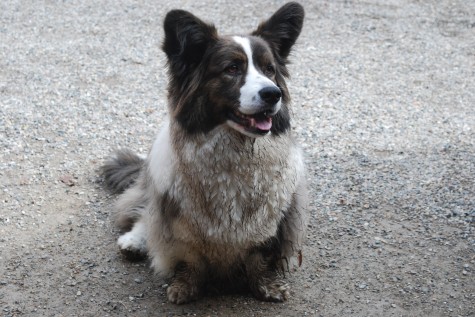 The contrast between Milo’s white fur, and the mud he’s been running through and spattering all over it is quite spectacular, is it not? I admit I could not take my eyes off of him. Contrast is all about those elements that are set in strong opposition to one another. In his case, clean and pristine white versus mud-dirty black. Contrast can be expressed in many ways-big versus small, textured versus smooth, light and dark. Relationships that emphasize differences are what creates contrast. In any case contrast is like a tuba in a brass band-oom pah pah.
The contrast between Milo’s white fur, and the mud he’s been running through and spattering all over it is quite spectacular, is it not? I admit I could not take my eyes off of him. Contrast is all about those elements that are set in strong opposition to one another. In his case, clean and pristine white versus mud-dirty black. Contrast can be expressed in many ways-big versus small, textured versus smooth, light and dark. Relationships that emphasize differences are what creates contrast. In any case contrast is like a tuba in a brass band-oom pah pah.
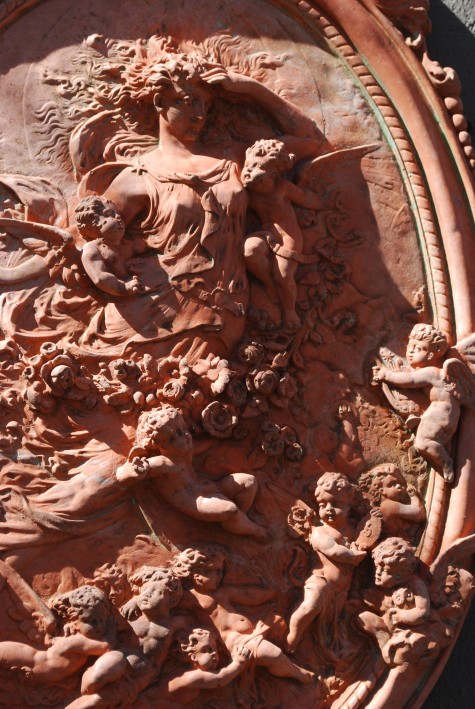 Contrast creates interest and excitement. The figures in this plaque were carved in such relief that they almost leap off the wall. The physical depth from the back plate to the outstretched hand of the most forward cherub is great-and even more greatly exxagerated by the late day sun. The slanting sun makes the darks very dark, and the lights almost white. There are not so many shades of grey. Like a silhouette, black and white makes the ultimate statement about contrast.
Contrast creates interest and excitement. The figures in this plaque were carved in such relief that they almost leap off the wall. The physical depth from the back plate to the outstretched hand of the most forward cherub is great-and even more greatly exxagerated by the late day sun. The slanting sun makes the darks very dark, and the lights almost white. There are not so many shades of grey. Like a silhouette, black and white makes the ultimate statement about contrast.
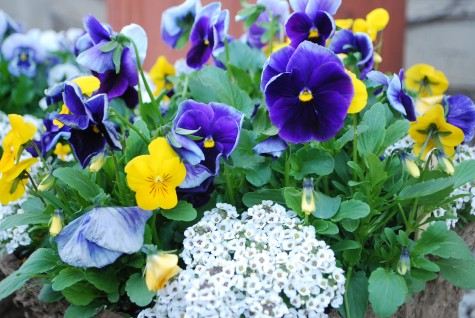 Color contrasts make for lively compositions. Purple and yellow together is a loud conversation across the color wheel. The white alyssum is a contrast in texture with the smooth textures of the pansy petals and leaves; there is a second conversation going on here. White contrasts dramatically with any intense color, and attracts attention from the eye at a distance. Small compositions can have big impact given a dose of white. This little eight inch pot has a lot going on for its size.
Color contrasts make for lively compositions. Purple and yellow together is a loud conversation across the color wheel. The white alyssum is a contrast in texture with the smooth textures of the pansy petals and leaves; there is a second conversation going on here. White contrasts dramatically with any intense color, and attracts attention from the eye at a distance. Small compositions can have big impact given a dose of white. This little eight inch pot has a lot going on for its size.
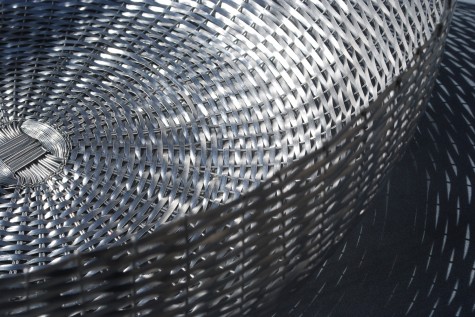 Metallic or shiny surfaces reflect light. But in this case, the contrast is relatively low. There are blacks, and shiny silver in this composition-but lots of grey tones in between. The eye moves from white to black with a lot of steps in between. This picture is easy on the eye, as the contrast is low.
Metallic or shiny surfaces reflect light. But in this case, the contrast is relatively low. There are blacks, and shiny silver in this composition-but lots of grey tones in between. The eye moves from white to black with a lot of steps in between. This picture is easy on the eye, as the contrast is low.
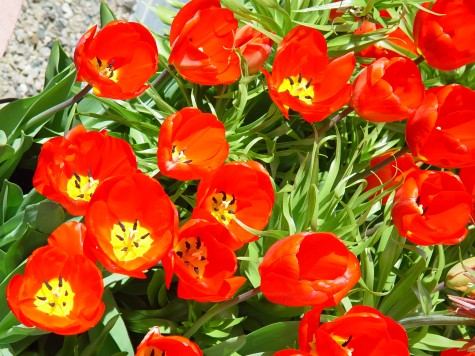 These electrically fiery red tulips set aginst their cooly green foliage is anything but calm and soothing. This has the same impact as a thunderclap right outside your bedroom window in the middle of the night. I wouldn’t anticipate anyone not following the contrast analysis here. The important part is choosing great contrast where it will be effective in a garden, and making a conscious decision for quiet where the garden benefits from quiet.
These electrically fiery red tulips set aginst their cooly green foliage is anything but calm and soothing. This has the same impact as a thunderclap right outside your bedroom window in the middle of the night. I wouldn’t anticipate anyone not following the contrast analysis here. The important part is choosing great contrast where it will be effective in a garden, and making a conscious decision for quiet where the garden benefits from quiet.
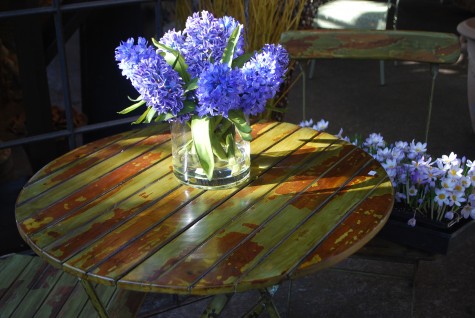 Subtle contrasts are not always so easy to spot-or plan for. Huge swaths of impatiens have cache from their mass, but they also may have that air of a shopping center planting. A group of shade tolerant plants providing contrasting textures, sizes and colors can be vastly more interesting. It’s important to pay attention to the stems and foliage that come with a flower-they are better than 50% of the visual output of the plant. Liriopes in pots-upright and grassy in texture, look great with green dichondra-that silvery round leaved trailer. They contrast in every way except their color. The fingered leaves of hellebores are all the better for a pairing with sweet woodriff. Their overall shape is very similar; their size differential is dramatically contrasting.
Subtle contrasts are not always so easy to spot-or plan for. Huge swaths of impatiens have cache from their mass, but they also may have that air of a shopping center planting. A group of shade tolerant plants providing contrasting textures, sizes and colors can be vastly more interesting. It’s important to pay attention to the stems and foliage that come with a flower-they are better than 50% of the visual output of the plant. Liriopes in pots-upright and grassy in texture, look great with green dichondra-that silvery round leaved trailer. They contrast in every way except their color. The fingered leaves of hellebores are all the better for a pairing with sweet woodriff. Their overall shape is very similar; their size differential is dramatically contrasting.
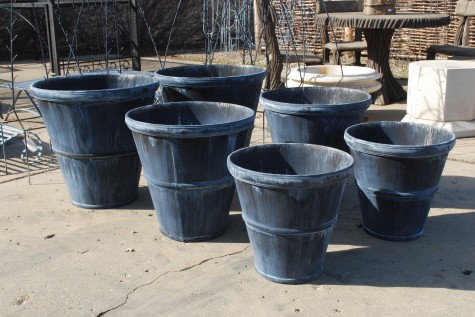 Some contrasting elements are slight-but enough to make a big difference. These V shaped steel pots are so much more striking for the steel bands that describe their shape. The banding catches the light, and solidly finishes the form.
Some contrasting elements are slight-but enough to make a big difference. These V shaped steel pots are so much more striking for the steel bands that describe their shape. The banding catches the light, and solidly finishes the form.

I have a particular fondness for a little color sass in the spring-for all the obvious reasons. They make a brave face when it’s still very cold here. I won’t want yellow and purple in my summer garden, but this kind of one-two punch is perfect for April. I’ve had temperatures in the 60’s the past two days-what a lovely contrast to my winter.
Leave a Comment